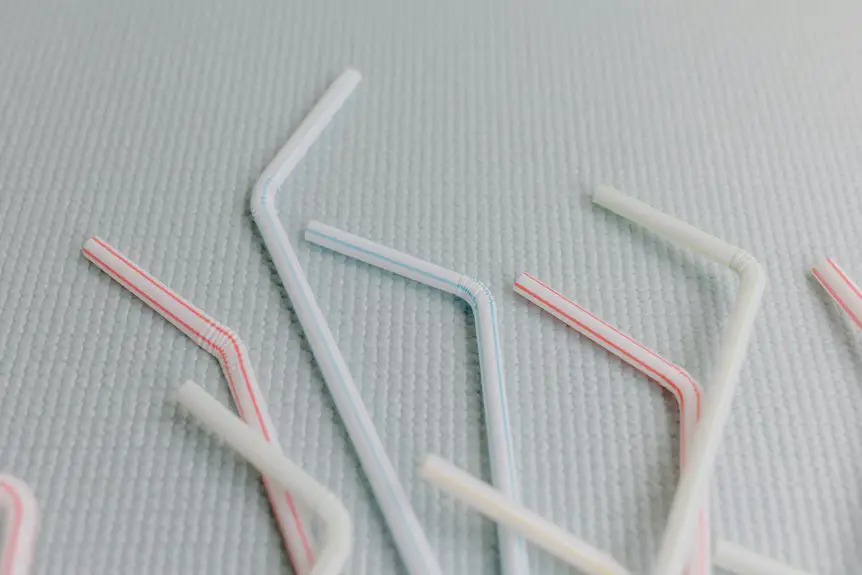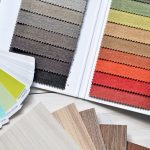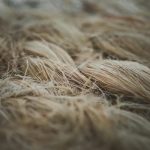You don’t have to worry about lyocell shedding harmful microplastics like synthetic fabrics do because it releases biodegradable cellulose fibers instead. Lyocell is made from natural wood pulp and breaks down quickly without leaving toxic residue. Its production uses a closed-loop system that minimizes environmental impact. When you wash lyocell, you’re contributing far less to microplastic pollution compared to polyester or nylon. Keep exploring to understand how this eco-friendly choice fits into sustainable fashion.
Table of Contents
Key Takeaways
- Lyocell sheds fibers during washing, but these are biodegradable cellulose, not plastic microfibers.
- It contributes significantly less to microplastic pollution compared to synthetic fabrics like polyester.
- Washing lyocell with gentle cycles, cold water, and mild detergents minimizes fiber shedding and environmental impact.
- Lyocell fibers break down naturally in soil and water within weeks to months without toxic residue.
- Sustainable lyocell production uses closed-loop systems and responsibly sourced wood, enhancing its eco-friendly profile.
Understanding Lyocell: Composition and Production
Although you mightn’t realize it, lyocell is a type of fabric made from sustainably sourced wood pulp, primarily from eucalyptus, beech, and spruce trees.
When you wear lyocell, you’re choosing a textile created through an environmentally friendly process called solvent spinning. This method dissolves wood pulp in a non-toxic solvent, then extrudes it into fibers without harmful chemicals.
You’ll find lyocell praised for its softness, breathability, and moisture-wicking properties. Its production uses less water and energy compared to traditional fabrics.
Unlike synthetic fibers, lyocell is biodegradable, breaking down naturally after use. Understanding its composition and production shows why lyocell stands out as a sustainable alternative in your wardrobe, offering comfort without compromising the environment.
What Are Microplastics and Why Do They Matter?
You mightn’t realize it, but microplastics are tiny plastic particles that come from products like synthetic fabrics and packaging breaking down.
These particles end up in our environment, harming wildlife and contaminating water sources.
Understanding their impact helps you see why reducing microplastic pollution matters for the planet’s health.
Definition and Sources
Microplastics are tiny plastic particles less than five millimeters in size that have become a growing environmental concern.
You might wonder where these particles come from and why they’re everywhere. Understanding their sources can help you make better choices.
Here are the main origins of microplastics:
- Primary microplastics: Manufactured small plastics used in products like cosmetics and cleaning agents.
- Secondary microplastics: Result from the breakdown of larger plastic items such as bottles and bags.
- Synthetic textiles: Fibers shed from clothes made of polyester, nylon, or acrylic during washing.
- Industrial processes: Abrasives and pellets used in manufacturing that escape into the environment.
Knowing these sources helps you see how daily activities contribute to microplastic pollution.
Environmental Impact
Because they’re so small, these plastic particles easily infiltrate ecosystems, posing serious threats to wildlife and human health. Microplastics come from various sources, including synthetic textiles, and once in the environment, they accumulate in water, soil, and air. You might not realize it, but these tiny plastics can enter your body through food and water, potentially causing harm over time. Understanding their environmental impact helps you make informed choices about the materials you use, like considering lyocell, a more sustainable fabric option.
| Impact Area | Description |
|---|---|
| Wildlife | Ingested microplastics harm animals |
| Water Pollution | Contaminates drinking water |
| Soil Quality | Affects plant growth |
| Human Health | Potential toxin exposure |
| Ecosystem Balance | Disrupts natural processes |
Comparing Natural Fibers and Synthetic Fibers
You’ll notice natural and synthetic fibers differ in composition, affecting how they shed microplastics and how long they last.
Understanding their environmental impact helps you make smarter choices about what you wear.
Let’s compare their durability and the microplastic pollution each type contributes.
Fiber Composition Differences
Anyone exploring textile materials quickly notices how natural and synthetic fibers differ in their composition. When you compare them, you’ll see distinct characteristics that affect their behavior, especially regarding microplastic shedding:
- Natural fibers like cotton and wool are made of cellulose or protein, breaking down more easily in the environment.
- Lyocell, though man-made, is also cellulose-based, derived from wood pulp, making it closer to natural fibers.
- Synthetic fibers such as polyester and nylon are petroleum-based polymers, which don’t biodegrade and shed plastic microfibers during washing.
- The chemical structure of synthetics resists natural breakdown, causing persistent pollution.
Understanding these differences helps you make informed choices about textiles and their potential impact on microplastic pollution.
Environmental Impact Comparison
Now that you understand how fiber composition influences microplastic shedding, it’s important to compare the broader environmental impacts of natural and synthetic fibers.
Natural fibers like lyocell come from renewable sources and biodegrade more easily, reducing long-term pollution. They also generally require fewer chemicals during production compared to synthetic fibers, which are petroleum-based and contribute to fossil fuel depletion.
Synthetic fibers shed persistent microplastics that accumulate in oceans and harm marine life. However, natural fiber cultivation can demand significant water and land resources, so sustainable farming practices matter.
When you choose lyocell, you support a fiber that balances biodegradability with lower chemical use. In contrast, synthetic fibers’ environmental toll extends beyond microplastics to energy-intensive manufacturing and non-biodegradability, making natural fibers a more eco-conscious choice overall.
Shedding and Durability
Although both natural and synthetic fibers shed microplastics during use and washing, their durability and shedding patterns differ markedly.
When you choose fabrics, understanding these differences helps you make sustainable decisions.
- Synthetic fibers like polyester shed tiny plastic particles that persist in the environment.
- Natural fibers, including lyocell, shed biodegradable particles that break down more easily.
- Synthetic fabrics tend to be more durable but release more microplastics with each wash.
- Lyocell offers a balance—it’s strong yet sheds fewer persistent microplastics compared to synthetics.
The Science Behind Microfiber Shedding
When you wash fabrics like lyocell, tiny fibers can break loose and enter the water system. This process, known as microfiber shedding, happens because washing agitates the fabric, loosening fibers from its surface.
The structure of lyocell fibers—made from regenerated cellulose—differs from synthetic fibers, affecting how they release microfibers. Natural fibers like lyocell tend to break down into biodegradable particles rather than persistent plastic microfibers.
Factors such as water temperature, detergent type, and washing machine action influence how many fibers shed. However, the science shows that the shedding mechanism depends on fiber composition and fabric construction, meaning not all fabrics release microfibers equally.
Understanding this helps you make informed choices about fabric care and environmental impact.
Does Lyocell Release Microplastic Fibers?
How does lyocell behave when it sheds fibers during washing? Unlike synthetic fabrics, lyocell is a cellulose-based fiber derived from wood pulp, so it doesn’t release microplastic fibers.
Instead, when lyocell sheds, it releases biodegradable cellulose fibers that break down naturally in the environment. Here’s what you should know:
- Lyocell fibers shed as natural cellulose, not plastic.
- These fibers decompose quickly, reducing environmental harm.
- Washing lyocell garments contributes far less to microplastic pollution.
- You can enjoy lyocell’s comfort without worrying about plastic pollution.
Environmental Impact of Lyocell Production
Because lyocell is made from wood pulp, its production impacts the environment differently than synthetic fibers.
You’ll find that lyocell’s manufacturing process uses a closed-loop system, which recycles water and solvents, minimizing waste and pollution. This efficient method reduces chemical discharge compared to traditional viscose production.
However, you should consider the source of the wood pulp—responsible sourcing from sustainably managed forests is essential to prevent deforestation and habitat loss.
Also, energy use during production can contribute to its environmental footprint, depending on the energy source.
While lyocell generally has a lower environmental impact than petroleum-based fibers, it’s not entirely impact-free.
Biodegradability of Lyocell and Its Effects
Understanding lyocell’s biodegradability helps you gauge its true environmental impact beyond production. Unlike synthetic fibers, lyocell breaks down naturally, reducing long-term pollution.
When lyocell fibers enter the environment, you can expect:
- Rapid decomposition in soil and water within weeks to months.
- Minimal toxic residue, as lyocell is derived from natural cellulose.
- Reduced contribution to microplastic pollution compared to polyester or nylon.
- Enhanced soil health by breaking down into organic matter, supporting ecosystems.
This biodegradability means lyocell doesn’t accumulate as persistent pollutants, making it a more eco-friendly choice.
However, remember that biodegradability depends on environmental conditions like temperature and microbial activity. So, while lyocell is sustainable, responsible disposal still matters to maximize its environmental benefits.
How Washing Practices Influence Fiber Shedding
While washing lyocell garments, you’ll notice that certain practices can increase fiber shedding, which contributes to microplastic pollution.
To minimize this, avoid washing lyocell with rough fabrics like denim or towels, as friction between fibers causes more shedding. Use a gentle cycle and cold water to reduce agitation and fiber breakage. You should also skip harsh detergents and opt for mild, liquid formulas that don’t weaken the fibers.
Turning your lyocell clothes inside out protects the surface fibers during washing. Avoid overloading the machine to allow proper movement without excessive rubbing.
Finally, air-drying is preferable since high heat from dryers can damage fibers, increasing shedding. By adjusting these washing habits, you help reduce fiber loss and support the sustainability of your lyocell pieces.
Innovations in Reducing Textile Microplastic Pollution
Minimizing fiber shedding through careful washing is a great start, but tackling microplastic pollution requires innovative solutions beyond individual habits.
Reducing fiber shedding helps, but solving microplastic pollution demands innovation beyond personal efforts.
You’ll be glad to know that the textile industry is actively developing technologies and materials to reduce microplastic release.
Here are four key innovations:
- Advanced fiber engineering: Creating fibers that shed less during wear and washing.
- Biodegradable coatings: Applying eco-friendly finishes that bind fibers more securely.
- Filtration systems: Installing microplastic filters in washing machines to capture fibers before they enter waterways.
- Closed-loop recycling: Designing processes that recover and reuse fibers, preventing waste and pollution.
Consumer Choices and Sustainable Fabric Care
You can reduce microplastic pollution by adopting eco-friendly laundry habits and choosing detergents with low environmental impact.
Taking care of your lyocell garments properly helps extend their lifespan, cutting down on waste.
Let’s explore how these simple changes make a big difference.
Eco-Friendly Laundry Practices
Because laundering habits directly affect the release of microplastics, you can make a significant impact by choosing eco-friendly laundry practices.
Here’s how to reduce your environmental footprint:
- Wash clothes less frequently to minimize fiber shedding.
- Use cold water cycles to protect fabric integrity and save energy.
- Opt for a front-loading washing machine, which is gentler and uses less water.
- Use a microfiber-catching laundry bag or filter to trap fibers before they enter waterways.
Choosing Low-Impact Detergents
While selecting detergents might seem like a small choice, it plays an essential role in reducing microplastic pollution and protecting fabric quality.
You should opt for low-impact detergents that are biodegradable and free from harsh chemicals like phosphates and synthetic fragrances. These detergents break down more easily in water, minimizing environmental harm.
Choosing formulas designed for sensitive fabrics also helps maintain lyocell’s softness and strength, preventing premature wear.
Avoid detergents with microbeads or plastic packaging to reduce plastic waste further. Concentrated detergents mean you use less product per load, cutting down on chemical runoff.
Extending Fabric Lifespan
Taking care with detergent choices sets the stage for longer-lasting fabrics.
To truly extend your lyocell garments’ lifespan, you need to handle them thoughtfully. Here’s how you can make a difference:
- Wash in cold water to prevent fiber damage and color fading.
- Use a gentle cycle to reduce friction and wear.
- Avoid over-drying; air drying preserves fabric integrity better than high heat.
- Store garments properly—fold instead of hanging to prevent stretching.
The Role of Lyocell in a Circular Fashion Economy
As you explore sustainable fashion, you’ll find that lyocell plays an essential role in advancing a circular fashion economy.
Made from sustainably sourced wood pulp, lyocell is biodegradable and compostable, which means it can return to the earth without harming the environment.
When you choose lyocell, you support closed-loop production systems that recycle solvents and minimize waste.
Plus, lyocell’s durability helps you extend garment life, reducing the need for frequent replacements.
By integrating lyocell into your wardrobe, you contribute to reducing landfill waste and lowering reliance on synthetic fibers that shed microplastics.
Embracing lyocell aligns perfectly with circular principles, ensuring materials stay in use longer and return safely to nature, helping you make more responsible and eco-friendly fashion choices every day.
Future Research Directions on Textile Microplastic Release
How can we better understand and reduce textile microplastic release? You play a key role in pushing research forward.
To tackle this issue effectively, focus on:
- Developing standardized testing methods to measure microplastic shedding across various fabrics, including lyocell.
- Investigating how different washing techniques and detergents impact microplastic release.
- Exploring innovative fabric treatments or blends that minimize fiber loss during use and laundering.
- Evaluating the environmental fate and impacts of natural versus synthetic microfibers to guide sustainable textile choices.
Frequently Asked Questions
Can Lyocell Fabric Cause Skin Allergies?
Coincidentally, if you have sensitive skin, lyocell fabric might cause mild allergies, but it’s generally hypoallergenic and breathable. You’ll likely find it comfortable, though always test new fabrics to avoid unexpected reactions.
How Does Lyocell Compare in Cost to Cotton?
You’ll find lyocell usually costs a bit more than cotton due to its sustainable production process. However, its softness and durability often make it worth the extra investment for comfortable, eco-friendly clothing options.
Is Lyocell Suitable for Athletic Wear?
Like a trusty sidekick in your workout saga, Lyocell keeps you cool and dry with its moisture-wicking power. You’ll love its softness and breathability, making it a great choice for athletic wear that won’t quit on you.
What Countries Primarily Produce Lyocell?
You’ll find that countries like China, Austria, and the United States primarily produce lyocell. These regions have advanced manufacturing facilities and sustainable processes, making them leaders in lyocell fiber production globally.
How Long Does Lyocell Clothing Typically Last?
Imagine your favorite shirt still feeling soft after countless washes—lyocell’s durable fibers make that possible. You can expect lyocell clothing to last several years with proper care, resisting wear while staying breathable and comfortable.
- Is Lyocell Stretchy? Understanding the Fabric’s Elasticity (Elastisch Explained) - July 14, 2025
- Can You Bleach Lyocell? What to Do Instead for Stains - July 14, 2025
- The Disadvantages of Lyocell: 5 Cons to Consider Before Buying - July 14, 2025







